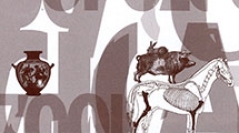

 Anthropozoologica
46 (1) - Pages 47-64
Anthropozoologica
46 (1) - Pages 47-64One of the characteristic productions of the Egyptian Naqada predynastic culture is the painted vases. Between 3700 and 3400 BC, they frequently display scenes in which a male character presents short, curve objects, simple or double, to three other iconographic elements: women with arms over the head, addax or banners. These short objects have traditionally been interpreted as sticks of power, but an attentive examination leads us to reconsider this hypothesis. It could be interpreted more likely as horns of addax or ibex. Silhouettes drawn by the women and the banners correspond moreover to forms of horns, and the presence of addax and ibex in these scenes strengthens this association. This interpretation would lead to a new reading of that type of iconography, more closely related to a regeneration of life topic than the preservation of the cosmic balance held by the political ruler, as the classical reading in terms of sticks of power used to suggest.
Egypt, Prehistory, iconography, gazelles, horns.